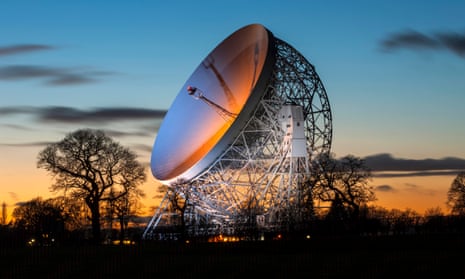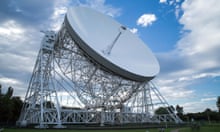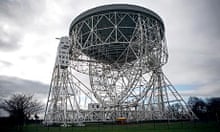The giant telescopes of Jodrell Bank, and the scruffy buildings surrounding them in which discoveries were made that helped change the understanding of the universe, have been nominated by the British government as a Unesco world heritage site.
The observatory, part of the University of Manchester, was founded in 1945 when Sir Bernard Lovell moved his laboratory from the murk and radio interference of the city to the clearer skies of Cheshire. It is known worldwide for its pioneering work, and is now the earliest surviving radio astronomy observatory, including structures on the still-working site from every phase of the development of the science.
Professor Teresa Anderson, director of the discovery centre at Jodrell Bank, said they had been working on the case for nomination for several years. “The Jodrell Bank Observatory, and Lovell Telescope in particular, have become icons of science and engineering around the world, and we’re delighted to reach this milestone.”
The Lovell Telescope, just under 90 metres tall, was the first of its kind in the world, and is still the third largest. Like the later Mark II telescope it already has grade I listing, but last August Historic England also listed the modest collection of industrial sheds surrounding it, including the Lovell’s 1950s control room and the electrical workshop that served as site office, library and lecture room. The listing was announced to mark the 60th anniversary of the Lovell first beginning to collect radio waves from across the universe: two months later it tracked Russia’s Sputnik I as it streaked across the skies.
Professor Tim O’Brien, associate director of Jodrell Bank, said it was an significant site not just in the north-west of England but to people across the world. “It is the one remaining site worldwide which has been a working observatory from the very first days of radio astronomy to the present day. It’s important that we protect its rich heritage as we celebrate its current and future work.”
Jodrell Bank will be put forward to become the UK’s 32nd world heritage site in 2019, the first since the Lake District joined the list last year.
Heritage minister Michael Ellis said the site was of global importance. “The nomination process for Unesco is rightly thorough, but I believe Jodrell Bank deserves to be recognised.”
The site may have an easier ride than the government’s last science nomination, for Charles Darwin’s home in Kent and the countryside around it where he walked daily and formulated his theories on the origin of species. The nomination was first withdrawn when the government was advised it was likely to fail, and then reformulated as “Darwin’s Landscape Laboratory” – but nine years later is still languishing on the “tentative list” of sites nominated but still being assessed.







